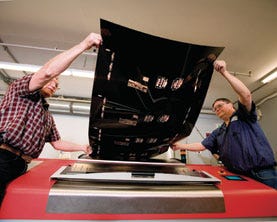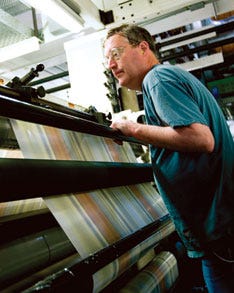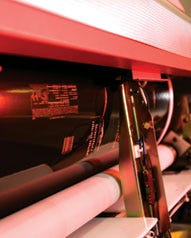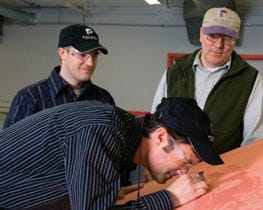Flex-pack plates go ‘green’...fast

Two platemakers lift a digitally imaged flexo plate from one of flexible-packaging printer Pliant's new themal developers.
Conventional wisdom says there are few "win-win" situations when implementing new technology—especially one offering significant environmental benefits. There always seems to be a tradeoff. But the DuPont™ Cyrel® FAST thermal flexographic-platemaking system, used in a digital-prepress workflow, confounds this thinking. Its environmental, quality and productivity performance can surpass the best traditional methods.
Just ask printing managers and staff at flexible-packaging printer Pliant Corp.'s Kent, WA, converting plant. The Cyrel FAST system cut total plate-production time by 75 percent, improved plate-shop productivity by 30 percent without additional staff, eliminated the cost of spot-buying finished plates from outside sources and enhanced final print quality. Along the way, it also removed environmental drawbacks from Pliant's previous solvent-washout platemaking system. Located between Seattle and Tacoma near the picturesque Puget Sound, the Kent facility produces printed bags and rollstock from extruded polyolefin films. The plant covers 135,000 sq ft and operates 24/7. It is one of 23 Pliant Corp. plants and R&D facilities.

The press operator monitors the slitting of film on one of Pliant's CI-flexo presses.
End-use markets include personal care, frozen foods, bakery and poultry. Handled bags and rollstock using INNO-LOK® zippers are among Kent's specialty capabilities. Flexo is the sole printing method at the plant, employing five wide- and medium-width, 6- and 8-color cylinder and sleeve continuous-impression (CI) presses from Windmoeller & Hoelscher and Paper Converting Machine.
Until recently, Pliant had produced plates in an internal plateroom using a traditional solvent-based washout system. The Kent facility serves its own internal plate requirements as well as Pliant's converting site in McAlester, OK. But in 2005, when DuPont introduced the Cyrel FAST 4260 unit, a wide-web platemaking system that uses thermal technology to eliminate the solvent washout and drying steps, Kent operations manager Brad Ehlers wanted to learn more about them. While chemically washing out exposed plates had been the standard for years, Ehlers says, the process has numerous drawbacks, including safe solvent storage, lengthy record keeping, strict regulatory oversight, stringent cleaning of accidental spills and unpleasant chemical odors throughout the plateroom. He adds that this goes against the flow of the Puget Sound region, where many embrace environmental proactiveness, including the state's diligent Environmental Protection Agency (EPA).
"So any viable system that removes all chemical solvents from flexo platemaking piqued our interest immediately," Ehlers says. And while environmentalism was a major consideration, Ehlers and other plant specialists quickly discovered additional advantages of dry platemaking—higher print quality and improved productivity, as well as cost and time savings.

Any viable system that removes all chemical solvents from flexo platemaking piqued our interest immediately.
After initial research and meetings with DuPont Cyrel Packaging Graphics representative Jim Lacy, Pliant made the decision: remove the original solvent system in just five days, including one weekend, and re-equip the plateroom with two Cyrel FAST TD4260 thermal-developing units. The new system develops flexo plates up to 42360 in., making it ideal for medium- and wide-web presses (see the expanded online version of this article for more on "How Thermal Developing Works"). "We took a giant leap of faith doing this," recalls Ehlers. "It was a one-hundred-percent changeover— solvent out and dry in." And as the saying goes, "failure was not an option." Falling behind in the platemaking transition would mean that Pliant's presses would be idled at the Kent plant, forcing other Pliant sites to take up the slack. And if Ehlers and his team weren't satisfied with the print quality and performance of Cyrel FAST, DuPont would incur the time and expense of reinstalling the old solvent system.

A finished plate emerges from Pliant's new platemaking system.
"We were confident of our trustworthy partnership with DuPont," Ehlers says. "Cooperation was in everyone's interest, and the teamwork between DuPont and Pliant was outstanding, perhaps best exemplified by how quickly the FAST system was up." Both units were successfully installed and fully functional in only three days—two days ahead of schedule. Press-ready plates were produced by the fourth day, and they performed remarkably, adds Ehlers. "Our expectations couldn't have been better met. Typically, you don't achieve this level of success when 'dropping-in' a major process change."
Recognizing the winning outcome, the Kent plant soon sold its original solvent equipment. There is no going back.
Initial benefits involve platemaking speed and staff productivity. "With the FAST system, we now have a fully produced dry plate in less than two hours versus five or more with solvent washout," explains Paul Schneider, a platemaker at the plant. "This includes back, image-wise and post exposures, trimming and finishing to make the plate press-ready. Actual thermal developer time is roughly twenty minutes. "With the old solvent washout and plate-drying steps taking nearly three hours, we simply couldn't put enough plates through to meet demand. We continually had to go outside to have plates made, and this added both time and cost."
Pointing out workflow improvements, platemaker Ed Nelson says, "FAST streamlines the entire process. There are no long stretches of dead time while a plate processes. We work faster and smarter." This is the major reason behind the shop's 30-percent increase in plate production without additional staff. "Before switching to FAST, we could process only ten to twelve sheets per shift," Nelson adds. "We've now doubled that output, making up to twenty-four sheets every shift."

A finished flexo plate is closely inspected prior to mounting on the press.
Major cost savings also result when an occasional plate gets damaged on-press. Replacements can be produced in an hour instead of four or five with the old solvent process. "That's a tremendous savings because now it has become a more realistic option to idle a press for one hour for a new plate instead of shutting down a whole line for four or five," says Schneider.
Pressroom response is equally enthusiastic. "The special Cyrel FAST plates perform on-press like solvent-based ones, yet mount quicker, provide more vibrant color, come up to color faster and last longer," explains plant engineer Barry Anderson. "We previously had to change solvent-made plates at one-million impressions. With FAST, we're regularly achieving one-and-a-half million, with pristine dots and higher definition in the mid-tones. And we consistently hit 120-line screens with ease. We wouldn't even think about returning to solvent washout," Anderson says, reflecting on the new system's environmental benefits. "The chemical odors are gone, employees are happier and since liquids are now eliminated from platemaking, all the bookkeeping and storage hassles we used to experience have disappeared."
The plateroom used to consume 20 55-gal drums of solvent a month. In contrast, Cyrel FAST runs very clean and practically odor-free, says Ehlers. "Everyone at the Kent plant is happy with the change. When we performed regular maintenance on the old solvent-washout system, it literally stunk up the whole building," he recalls. "People complained all day about the odor. They don't anymore." That's why Pliant plant management and its staff feel that dry, thermal platemaking offers a true "win-win" solution. "There are no significant drawbacks," Ehlers concludes. "You'd be foolish not to use it."
More information is available:
DuPont Cyrel, 800/345-9999. www.cyrel.com
Paper Converting Machine Co., 920/494-5601. www.pcmc.com/pcmc/flexo
Pliant Corp., 253/872-2253. www.pliantcorp.com
Windmoeller & Hoelscher Corp., 800/854-8702. www.whcorp.com
About the Author(s)
You May Also Like


